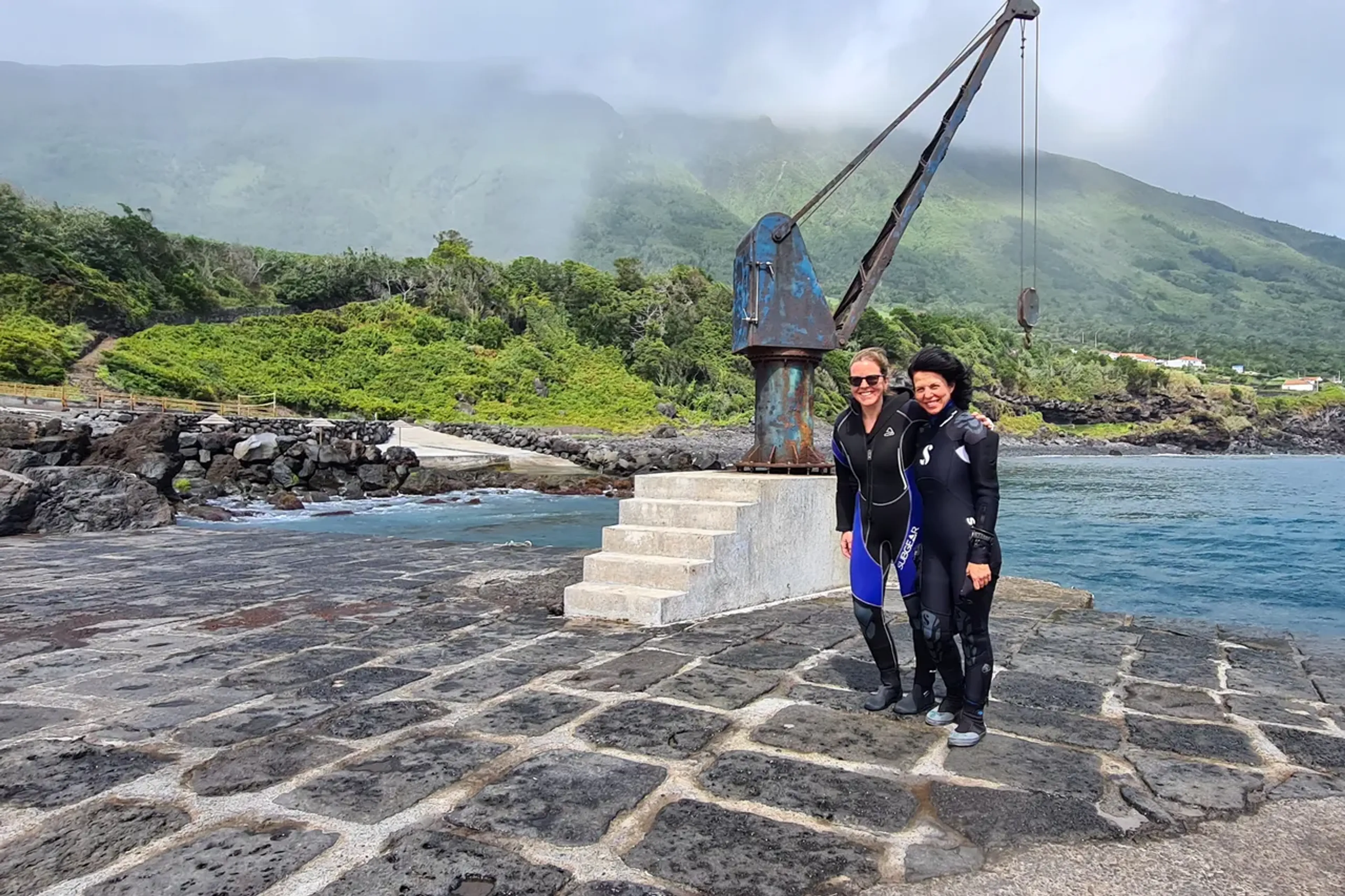Isabelle Barbier
• 7 min read
Azores, Portugal, is often claimed to be the best scuba diving destination in Europe. From Pico island, you can access Princess Alice, a world-famous dive site full of exciting species. You can also dive with the fastest sharks on earth, the blue sharks. Are the Azores indeed one of Europe's best-kept-secret for scuba-diving? With the COVID-19 pandemic limiting travel outside Europe, we decided to give it a go this summer and headed to Pico island for a week.
The Azores archipelago is made of nine major volcanic islands, located in the North Atlantic Ocean, about 1,500 km (930 miles) from Lisbon, and 3,900 km (2,400 miles) from the east coast of North America. It is easier to reach than you think. There are direct flights from Lisbon, Portugal, and even from North America, with Toronto, Canada and Boston, USA. Expect to see there some lush islands with dramatic landscapes, lakes, and peaks.
On July 12, 2021, world-famous oceanographer and Mission Blue Founder Dr. Sylvia Earle announced the Azores as a new Hope Spot. Azorean President José Manuel Bolieiro announced his commitment to protect an additional 15% of the Azorean waters as a no-take, bringing the total protection to 20%! Let's take you into Sylvia's steps.
More Than 28 Species of Cetaceans Known Worldwide Are in the Azores
The Azores has long been an archipelago whose main source of income was whaling. In 1986, the whaling activity was banned for good. The Azores has since been developing eco-tourism instead, and it is now known for its whale-watching tours. With more than a quarter of all cetaceans (dolphins and whales) known worldwide, the half-days going out on the sea can be very rewarding! Sperm whales, humpback whales, and blue whales are some species you can see in the Azores. The best season for whale-watching is from April to October.
Pico island hosts the highest peak of Portugal, Mount Pico, attracting hikers from mainland Portugal. Still an off-the-beaten-track destination, it has, however, good infrastructures. Locals are friendly, the food is excellent, and prices are very reasonable. After spending a week there, we think it is a great holiday destination for everyone: single travelers, groups of friends, couples, and families!
Diving Conditions Are Best in July-August
The diving season is short, and the best months to go are July and August. The Azores can be subject to strong winds and rapidly changing weather, so you want to maximize your chances of having the best diving conditions with going at this time of the year.
Water temperature-wise, the average in July-August is 21°C (68°F). We wore a 7mm wetsuit, a hood, and some gloves. Of course, with all these, we needed a fair amount of weight. Some of us went from using 3 pounds in tropical waters with no wetsuit to 22 pounds in the Azores!
Pico island, Azores is suited for both beginner and more experienced divers. There are plenty of protected dive sites and also some more challenging ones with currents. Negative entries were the norm whenever currents were strong.
Despite going there in August, it was almost impossible to plan the dives from one day to another. This fast-changing weather is usual. If you remain flexible and don't mind the rain, you can dive every day.
Santa Maria Island is famous for diving with whale sharks. As we had already seen some previously, we decided to go to Pico island instead, which seemed to offer a greater diversity of diving experiences.
Experience Shore Diving and Boat Diving
There are two major dive shops on the island, and we went diving them both.
With Twin Peaks Diving, we did some shore dives on the northern coast, where we got to see several octopuses and some beautiful macro life (bring a torch) in some caves. We also got to experience some swell, which is always good fun!
With Pico Sports we went to the southern coast for shore diving, which we particularly liked. We were pleasantly surprised by the diving conditions in Saõ Caetano and Saõ Mateus, with excellent visibility even on days with pouring rain.
We enjoyed the beautiful topography with arches and walls. Our dive guide, Oli, even rescued a moray eel during one of the dives. This gave everyone a big smile - big up to him for being a reef-friendly diver!
If you like pelagic life and are confident in currents, then it's best to do some boat dives. The dive sites with the most life in the area are in a triangle between Pico, Faial, and São Jorge islands. If that's the diving you're interested in, then we recommend booking your accommodation in Madalena town, which is the departure point for boat dives. This is also where Pico Sports is based at.
We preferred these dive sites as we saw more marine life, and we could dive on sites with pinnacles and currents. This is what we had been looking for when booking our flights to the Azores.
Also, boat diving meant we did not have to carry as much all the equipment and the extra weights, so this was definitively a more pleasant experience for us.
The good news is that whatever the conditions were, we managed to go diving. Whenever the waves were too big to get out with the boat, we did some shore diving. And what a pleasant surprise to get underwater, and discover excellent conditions despite the pouring rain above the water!
Stay at Least a Week to Maximize Your Chances to Go to Princess Alice Seamount
Of course, we had at the top of our list Princess Alice dive site, a seamount that rises from a depth of approximately 2,500 meters (1.5 miles).
The bank was discovered during an expedition of Prince Albert of Monaco in 1896. Princess Alice is located 85 km (52 miles) off Pico Island, and you need excellent conditions to get there with quite a small boat.
Divers who are lucky to get there usually see groups of up to 50 Mobula rays, some barracudas, triggerfish, some swordfish, and more. There is strong upwelling thanks to deep-sea currents, attracting all these species.
If you're lucky to go, expect to meet at the dive shop at 6 am and return around 7 pm. If you're prone to seasickness, then it's best not to go. The dive conditions are also challenging with strong currents. This is why dive shops use ropes divers can hang onto. The minimum level of diving to dive there is Advanced Open Water and at least 50 dives, with some experience in currents.
Even though we stayed for one full week, we could not go as the wind was too strong. Remember, you're basically in the middle of the Atlantic ocean!
The dive shop had a backup plan for us: a pinnacle called Baixa Rosais off São Jorge island. It was approximately an hour and a half boat ride from Pico. On this dive site, we got to see huge schools of barracudas. The current was quite strong, so our dive time was only about 40 minutes each time. One-third of the divers on the boat chose not to do the second dive - this is how strong the current was!
Dive With Blue Sharks
One of our objectives was also to see some blue sharks. Blue sharks can swim up to 70 km/h (45 miles an hour) thanks to their elongated shape. To see them, you need excellent sea conditions again! We'll dedicate an article to diving with blue sharks in the coming weeks - subscribe to our newsletter not to miss it.
In our next article, we'll also talk about all the other things you can do on Pico island besides diving. We'll recommend our favorite places to eat too, as there were a few gems there!


